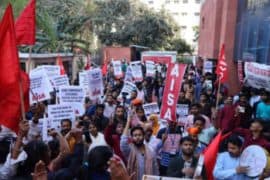Of all the major areas of research, linguistics is one such department in the University of Delhi which has been carrying on interesting and detailed work on the endangered languages of the India.
The scientific study of language is known as linguistics. In linguistics, syntax is the set of rules, principles, and processes that govern the structure of sentences in a given language, specifically word order. The term syntax is also used to refer to the study of such principles and processes. Semantics is primarily the linguistic, and also philosophical, study of meaning—in language, programming languages, formal logic, and semiotics. It focuses on the relationship between signifiers-like words, phrases, signs and symbols—and what they stand for, their denotation. All the languages have different syntax, semantics and tones. It is indeed a field of study which brings up the significance of the languages spoken in even nook and corner of the world.
Now, we have numerous lists of endangered species of flora and fauna in the world. Similarly, the socio-cultural importance of the 6,500 spoken languages around the world cannot be disregarded. UNESCO’s Atlas of the World’s Languages in Danger categorises 2,473 languages into five levels of endangerment: vulnerable, definitely endangered, severely endangered, critically endangered and extinct. Languages that are at risk of falling out of use as its speakers die out or shift to speaking another language are known as endangered languages. Language loss occurs when the language has no more native speakers and becomes a “dead language”. If eventually no one speaks the language at all, it becomes an “extinct language”. Linguists, members of endangered language communities, governments, NGOs, and international organizations are actively working to save and stabilize endangered languages. Once a language is determined to be endangered, there are three steps that can be taken in order to stabilize or rescue the language. The first is language documentation, the second is language revitalization and the third is language maintenance. Language documentation is the documentation in writing and audio-visual recording of grammar, vocabulary, and oral traditions of endangered languages. Language revitalization is the process by which a language community through political, community, and educational means attempts to increase the number of active speakers of the endangered language. Language maintenance refers to the support given to languages that need for their survival to be protected from outsiders who can ultimately affect the number of speakers of a language. Almost all of the study of language endangerment has been with spoken languages. A UNESCO study of endangered languages does not mention sign languages. However, some sign languages are also endangered, such as Alipur Village Sign Language (AVSL) of India. Many sign languages are used by small communities; small changes in their environment can lead to the endangerment and loss of their traditional sign language. Understanding the structure of these endangered languages of the world will help the linguists at least preserve of what has remained of those languages. Different languages portray different visions of life and apparently they help to know the civilisations better, the ancient, and also the modern ones.

One primary reason of highlighting this department is because of its unfamiliar field of exploration. Some of the research works taken up by the Post Graduate students of DU include Documentation and description of endangered languages, Historical Linguistics, Phonology, Morphology, Language contact, Psycholinguistics and Neurolinguistics, Linguistic Stylistics, Applied Linguistics, Generative Phonology, Translation Studies, Sociolinguistics, Lexicography. Indo-Norwegian Cooperation programme is a new initiative aimed to foster cooperation in education between the two countries. In its meeting on Oct 1 2014 the SIU-UGC joint committee granted permission to 15 projects. One of these INCP supported project is- A Micro comparative Study of Doubling in Dialects of Meiteilon and Norwegian as a Case of Syntactic Variation. Since then several workshops were held both in DU and Norwegian University of Science and Technology, Trondheim and Norway. Although not very old, this department of DU has not failed to amuse the international platforms with the numerous projects on Linguistics.
Image credits: onehourtranslation.com
Radhika Boruah




Comments are closed.